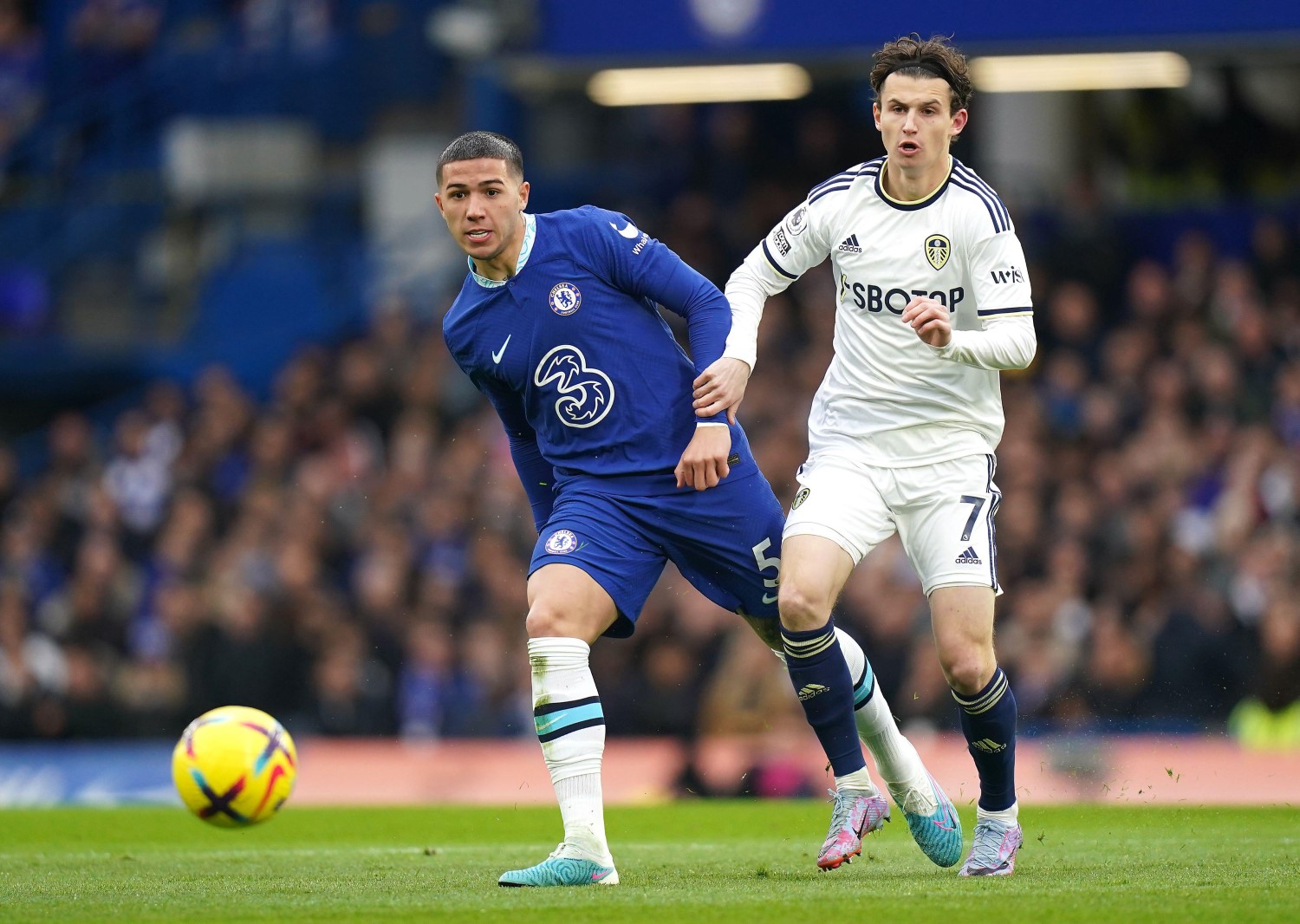Last year I used StatsBomb 360 data to take a look at players breaking lines with passes and with prizes down at "Chez StatsBomb" extending to "write more articles" this year I figured to take another look and see what jumped out. And then as we will see, I spied a hot young talent and investigated them.
The general details of what we're looking at to start with are in that prior post, but what you need to know is that to start with we're looking at completed open play line breaking passes, which we've clustered into types (that are collated together regardless of whether the emerged from opposite sides of the pitch), then ranked them by the On Ball Value (henceforth OBV, a possession value model) with a view to understanding who are the top performers in a given position grouping (in this case "midfielders", which themselves come from a pre-categorisation of given positions). What I liked about the prior analysis was that it brought together multiple different factors and model inputs, to gain insight about a specific element of the game which resonates widely with coaches and stakeholders - Line Breaking Passes. That tension between potentially complicated data work and accessibility remains a continuing facet of real world sporting organisations, so solving for all, if possible, is highly useful.
Let's take a look at midfielders in this season's Premier League:
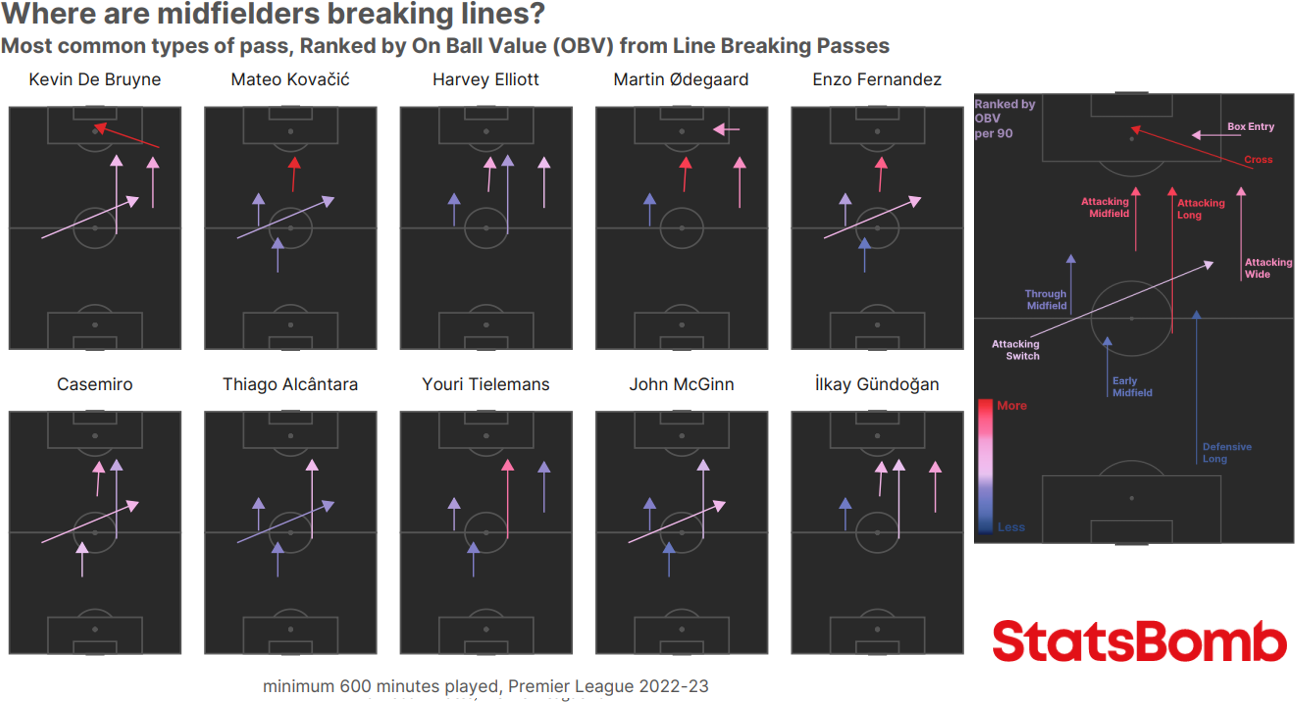
A major point here is to note that the colour scaling can do no justice to the value of Kevin de Bruyne's crossing, which clocks in bringing 0.11 OBV per 90 minutes played, while the next highest figure represented here is from Mateo Kovačić's passing through the attacking midfield zone, 0.04. We're getting a clear demarcation between the creative attacking passing type midfielder - yer De Bruynes, yer Ødegaards - and more of an inbetweener type who still skews towards the attacking side in Harvey Elliott (promising!) and İlkay Gündoğan. Then we have passing controllers like Thiago Alcântara, Youri Tielemans, Casemiro and er... John McGinn? Most of the players represented here are averaging 50-70 passes a game, McGinn is down on 32, but around 30% of those passes are line-breakers, a rate only exceeded by De Bruyne in this midfielder category (31%). Mathias Jensen popped up on last year's top list with a similar profile; he ranked 17th this time round, while last season's top scorer here Christian Eriksen exchanged his do-everything Brentford role for a more metronomic role at Man Utd and now ranks 15th. It's a testament to his enduring quality that he can do both.
So far i've missed off the Chelsea pair Mateo Kovačić and Enzo Fernández who are interesting as they profile very similarly. Let's take a look at Chelsea's midfield options this season via the same medium:
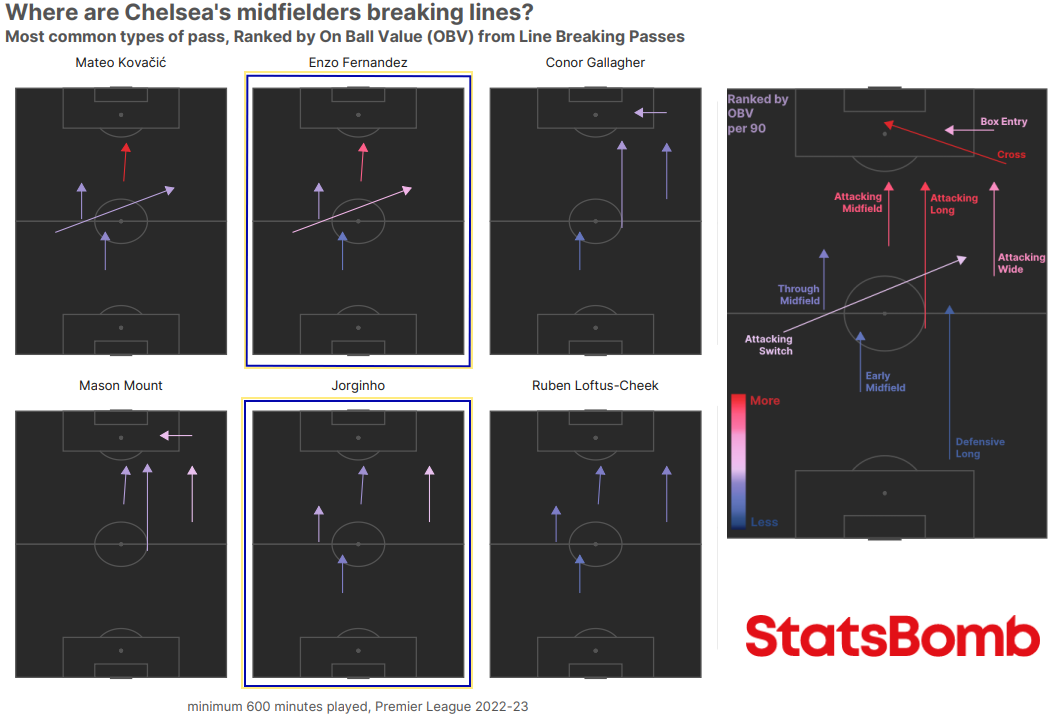
Mason Mount has played most of his time outside a central midfield slot, but has contributed and covered at times, and in game, most often when the team has nominally played in a three. As such his profile here is more that of an attacker, as one might expect. Mount, Ruben Loftus-Cheek and Conor Gallagher were mid-season options in the main, but have participated less in this area of the pitch since the World Cup. Loftus-Cheek has split time across various right / right central sided slots and I am charmed that his profile compares directly to the now departed Jorginho - learning from the master? Gallagher's profile fits a broad understanding of his talents; not much in build-up areas, but more higher up. He too has flitted around varying areas of the team, most recently reverting to a late game impact player. Not too much needs to be added on Kovačić who has spent the best part of a decade contributing in top sides and popping in metrics, while zooming out from the entire enterprise we find the shadow of N'Golo Kanté who may well be back in the starting mix soon enough.
What piqued my interest here was Enzo Fernández. Using the internet, I did my own research and it revealed that in recent months he had won the World Cup, been named the best Young Player in the tournament and secured a Premier League record transfer in January. I needed to find out more.
In an environment of high squad turnover, flexible formation choices and inconsistent results [editor note: and managerial changes], one thing has been utterly solid across the last two months at Chelsea: Fernández starts. From that I was curious how he was settling in, what he's doing for this team, and how that differed from the now departed former number five - Jorginho.
Across a bunch of metrics of varying importance, the value of Fernández in this team becomes quite clear.
Passing - 360 metrics
Using StatsBomb 360 data, we can home in on the some key elements that evade a standard event data sat. For example, Fernández ranks #1 in the Premier League among midfielders and behind only Trent Alexander-Arnold for open play Line Breaking Passes attempted (14.5 per 90, a clip above Kovačić). His added value above and beyond this can be extracted via the space his teammates are in when he finds them - an average of 5.9 metres - behind only Christan Eriksen among high volume line breakers. All of these measures replicate across the whole pitch and the opposition half, from which he ranks #1 to #3 across a slew of volume and spatial related subsets. And we know from the charts that a good volume of these passes are emerging via beneficial central areas or via switches.
Other metrics
There are 60 players in the Premier League who have played 600+ minutes and completed 87% or their passes or more (as Fernández has). Only Alexis MacAllister and Nampalys Mendy have attempted a higher proportion of those passes while "under pressure" (defined as within the parameter of an opponent applying pressure to the player) than Fernández's 17%. Furthermore, when passing under pressure, Fernández's pass completion % does not vary from his overall total, a feature he shares with only Gündoğan from that same list of 60 players. Everyone else drops off to some degree. Among midfielders of any variety, nobody has played a lower proportion of their passes backwards (5%) and only Ruben Neves has played a smaller percentage of passes backwards (1% to Fernández's 2%) in the opposition half. He's also completing around 80% of the nine long & high-passes he's attempting per game and showing some promise towards attempting and completing passes beyond the defensive line via throughballs, a feature of his time at former clubs, but for Chelsea in a sample too small to be of real note.
Defensively, there's a decent volume of pressure events going in there - 20.5 per 90 - and adjusted for opportunity this ranks #1 for midfielders. The resulting regains from both that pressure work and all defensive actions (including 3.2 tackles made per 90, 4th for midfielders) both rank top three as well.
All put together it paints an attractive picture. Fernández is a capable high volume passer, who possesses skill to vary his range and good vision to progress between lines, while clocking up effective defensive interventions for his team and usefully evading opponent pressure.
You know something? He might be quite good.
On the way out of Chelsea, Jorginho metaphorically tossed his number 5 shirt across the hall to Fernández. The Italian star had served the club well after being acquired for £50m plus add-ons on the same day that Mauricio Sarri joined as manager in 2018. Throughout his time at Chelsea, he was a precise and high volume passer and even beyond Sarri's departure and in a competitive squad, most usually a starter. His deficiencies were occasionally highlighted when a lack of physical power and defensive dominance could hinder him, but with variously Kante and Kovačić in the team, at times it could be covered.
Despite getting through a similar volume of passing work, so far Fernández offers a shade more bite and a subtly different style of passing. Specifically, in build up, he appears to let the ball do more work for him than even Jorginho did and that comes out in his tendency to go searching for the longer pass. We can see this when examining how each player supplies their teammates on either flank:
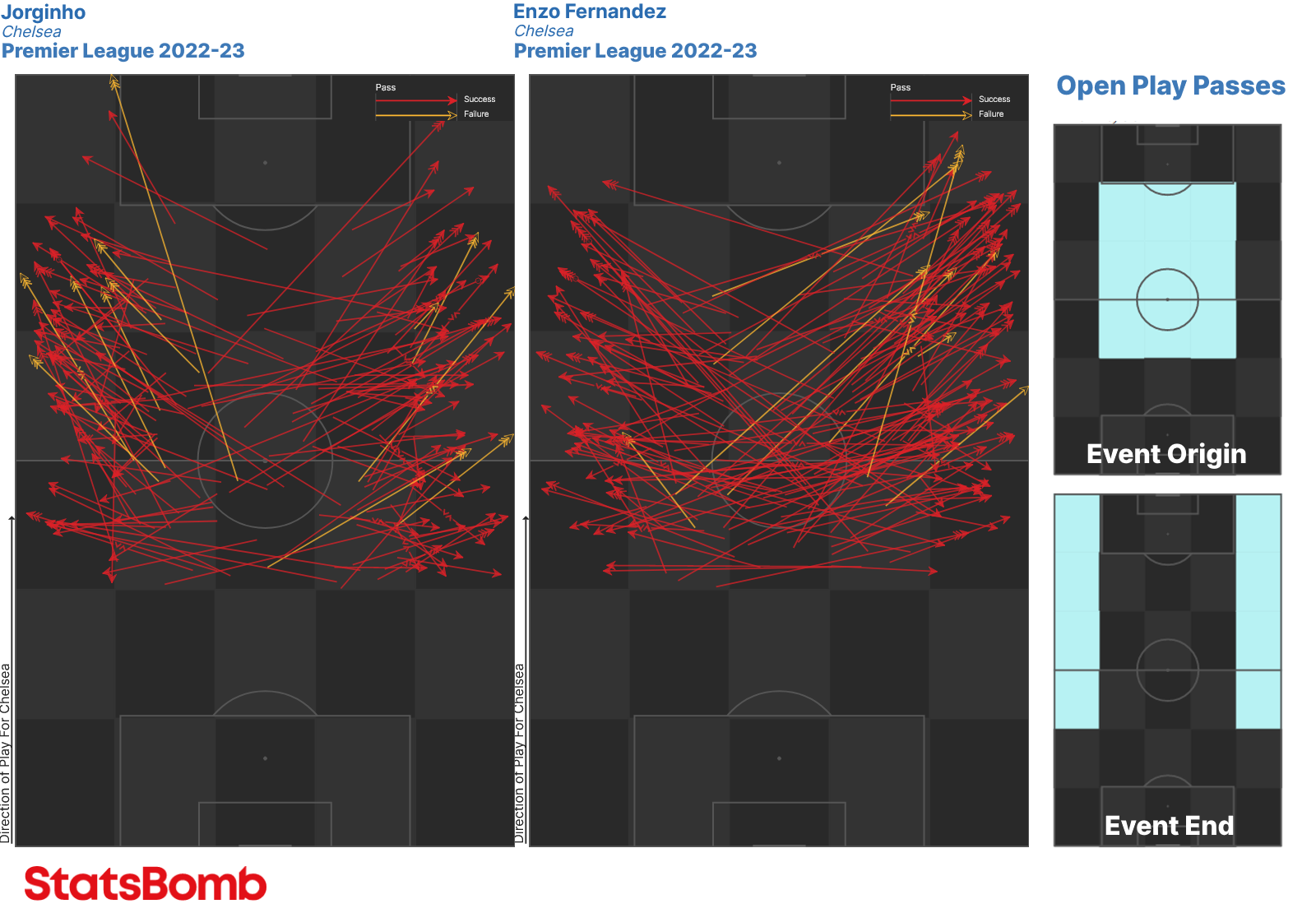
It's fairly clear from this pass map that Jorginho would track with the play, to enable shorter passes to his full backs and offer a continual outlet for returns. In comparison, Fernández is content to hit either flank with longer passes from range - these are often the switches we saw emerging to earlier via Line Breaking Passes. There's also an emerging trend for Fernández to try and hit the box, and the centre of the box specifically, in the less common moments that he moves into higher central locations, something that again differs from that which Jorginho tended to offer:
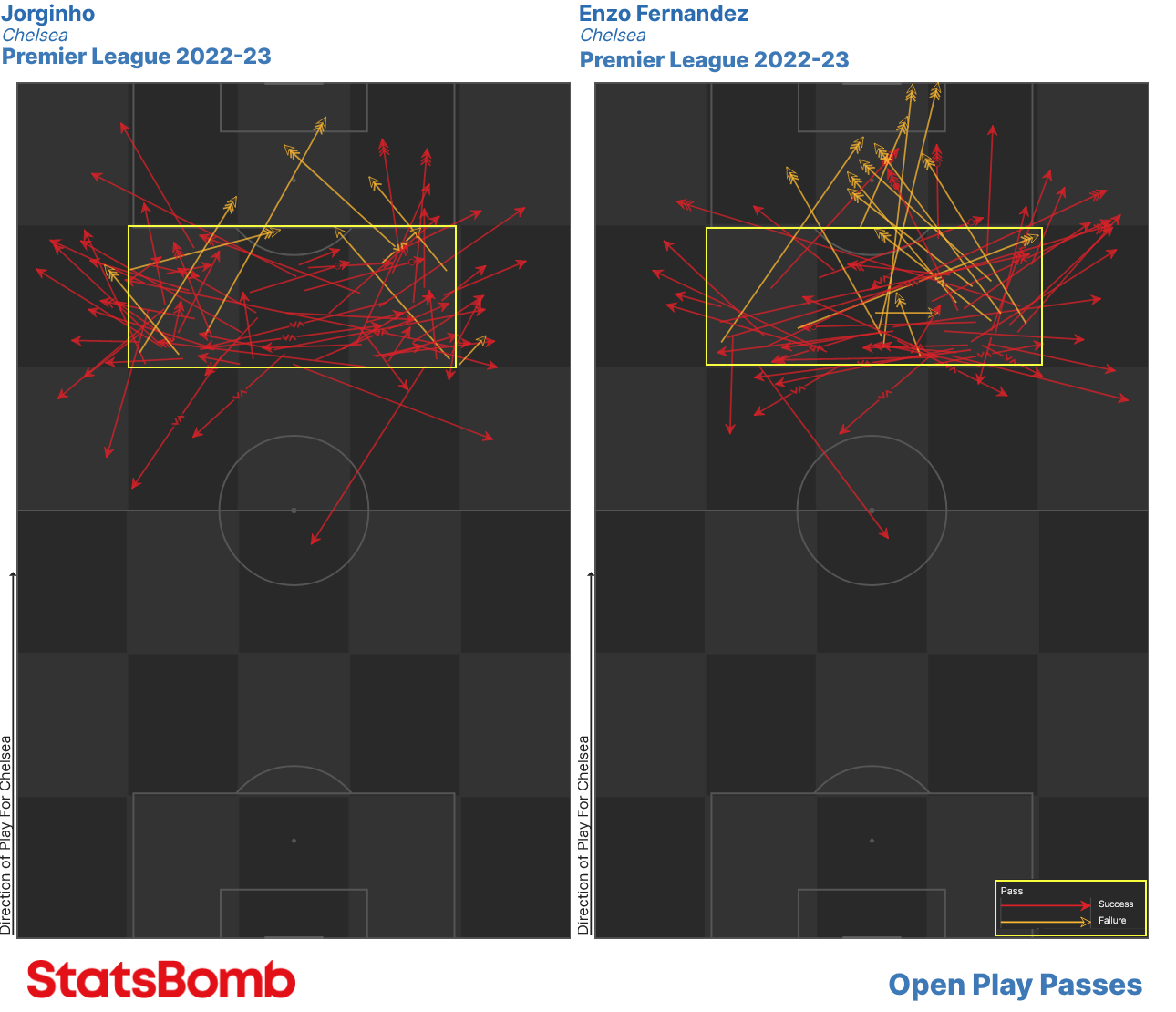
Does Fernández offer value at a league record fee? It's interesting to look back at the summer Jorginho arrived. There was a good bit of money spent on pre-peak / early peak central midfielders. Naby Keïta, Fred and Fabinho all arrived in the league in the £40-60m bracket, while Jefferson Lerma, Jean Michaël Seri, André-Frank Zambo Anguissa and Lucas Torreira were in the £25-30m tranche behind that. That's a really mixed return all in for a key position, and Jorginho sits very much in the preferred end of the list. Of course, the question of value around Fernández mainly orientates around how much Benfica paid for him mere months ago, but given his clear fast improving credentials, age, and now early returns, Chelsea may well have nailed down one starting position for at least as long as they got out of Jorginho, with a contractual implication towards more. Five years on, it's double Jorginho's fee. It's a lot of money: he's a really good player.
A note of caution? Chelsea have shown fairly mediocre form (although process slightly ahead of outcome!) in a theoretically softer run of fixtures since Fernández arrived. Of the top six only, they have only played Tottenham recently and Chelsea offered little in that game. Better times have been had in the Champions League where Borussia Dortmund were conquered across two legs. Fernández put a decent shift in both matches (ranked #2 for pressure volume in both) while having a clearly more "normal" passing game in the 1-0 defeat in Germany (high volume, high completion, a central hub). The return leg saw him sit right off, almost in the back line, as Chelsea negotiated their way through after finding a decisive lead early in the second half. Tougher tests will await in the near future, no doubt.
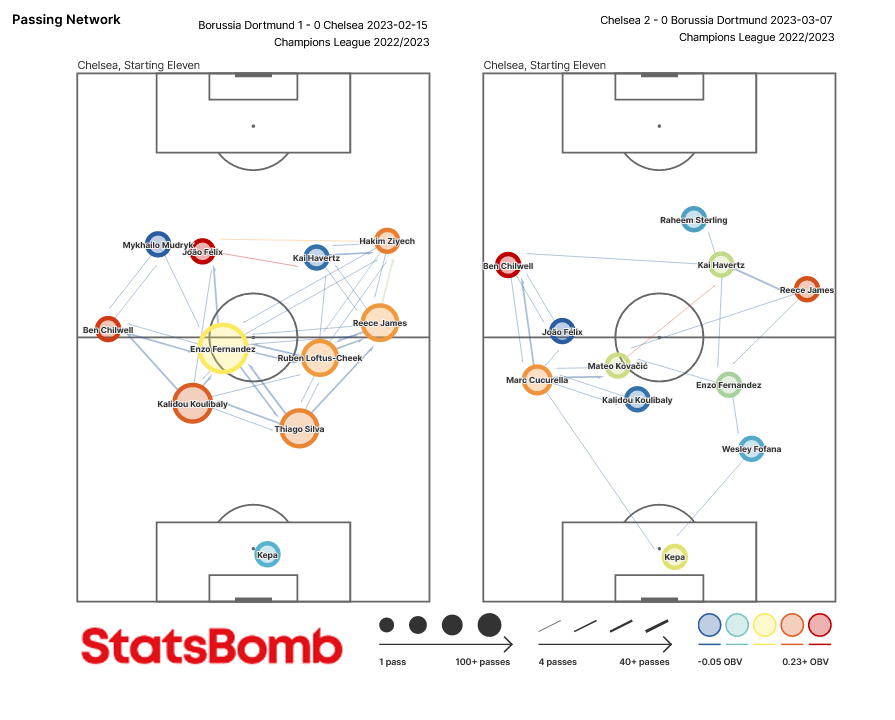
When looking for player types, using a mix of the qualities we have described here, the player who flagged closest was Marco Verratti - that mix of line breakers, pass volume, reliability with a bit of defensive bite is fairly scarce. You get a bit more ability to beat a man via a dribble from Verratti, and this is something that Fernández has shown very little of so far in a blue shirt, but you do get more frequent longer passing from him. What price a 22 year old Marco Veratti in 2023?
Let's wrap up. Regardless of who they appoint as their new manager, Fernández can be a key man for Chelsea's future. With Kanté and Kovačić apparently looking to be retained in the short term at least and options in the squad, central midfield does not look like an area the team is lacking. However, the rest of the league is always likely to be interested in picking up talented players who can break lines, and one player from our original chart (both this year and last) who is sitting on the cusp of his peak years is available on a free transfer this summer: Youri Tielemans.

